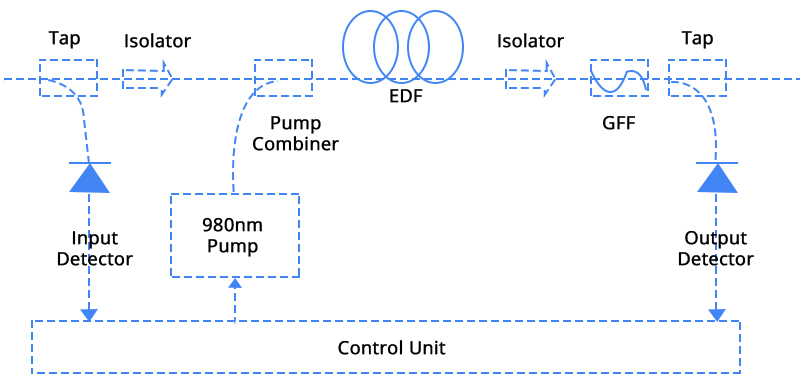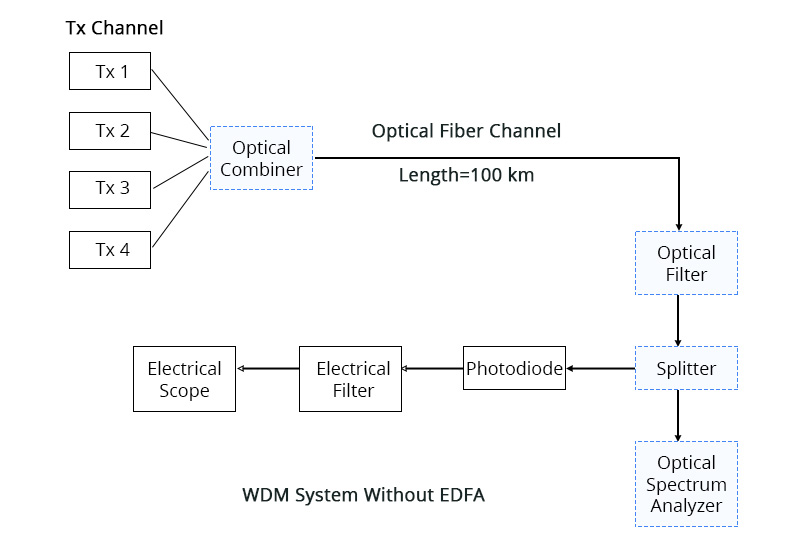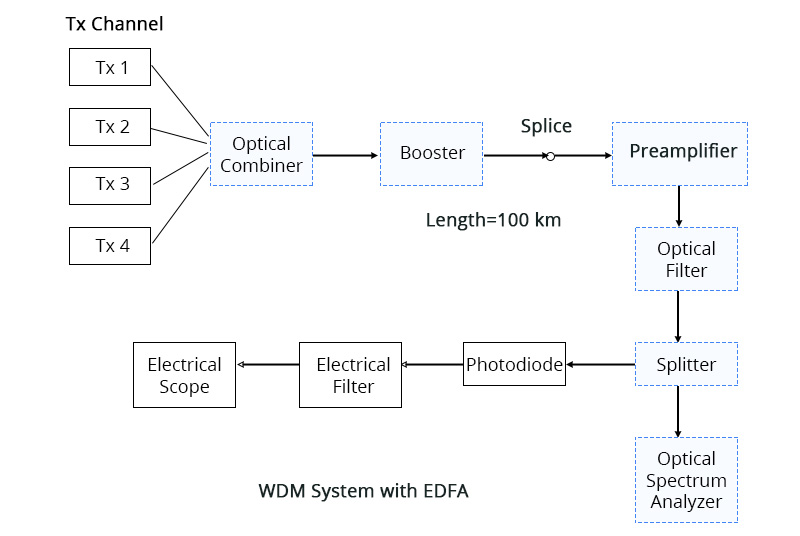How EDFA Benefits WDM Network System: In-depth Understanding of EDFA Application
Wavelength Division Multiplexing (WDM) technology, integrated within optical networks, is currently experiencing widespread adoption within existing telecom infrastructure. As integral components of long-haul data transmission, optical amplifiers offer a distinctive advantage by directly amplifying optical signals without needing signal conversion to electrical form beforehand. Paired with Erbium-Doped Fiber Amplifiers (EDFA), Wavelength Division Multiplexing (WDM) enables the conveyance of numerous channels through a solitary fiber, empowering data transfer across distances spanning from a few hundred kilometers to transoceanic expanses. This capability fulfills the data capacity demands of both current and future communication networks.
What Is Fiber Optic Amplifier EDFA and How Does it Work?
Due to losses caused by fiber attenuation, connections, and fusion splicing, power amplification is necessary for long-distance transmission of optical signals. Before the invention of optical amplifiers, signals had to convert to electrical form for amplification and then back to optical signals, a complex and costly process. The invention of optical amplifiers addressed this issue by enabling direct signal amplification, thereby substantially reducing costs and catalyzing a revolution in fiber optics.
Various fiber optic amplifiers exist, including semiconductor optical amplifier (SOA), fiber Raman and Brillouin amplifier, and erbium-doped fiber amplifier (EDFA). Among these, EDFA stands out as the most extensively utilized in WDM systems. Employing erbium-doped fiber as its amplification medium, EDFA directly enhances signals. In contemporary long-haul optical communication, EDFA is frequently used to counteract fiber loss. Its crucial attribute is its ability to simultaneously amplify multiple optical signals, making it easily compatible with WDM technology. Typically operating within the C band and L band, roughly in the range of 1530 to 1565 nm, it's important to note that EDFAs cannot amplify wavelengths shorter than 1525 nm.

The cornerstone of EDFA technology lies in the Erbium Doped Fiber (EDF), a conventional silica fiber infused with erbium. An EDFA comprises an EDF segment, a pump laser, and a WDM combiner. The WDM combiner merges the signal and pump wavelengths, enabling them to traverse the EDF concurrently. EDFA can be set up with pump energy traveling either in the same direction as the signal (forward pumping), in the opposite direction to the signal (backward pumping), or simultaneously in both directions. The pump energy may be at 980nm, 1480nm, or a combination of both. The most prevalent configuration is forward pumping utilizing 980nm pump energy. This setup leverages 980nm semiconductor pump laser diodes known for their cost-effectiveness, reliability, and low power consumption, thus offering the optimal balance between performance and cost.

Case Study: How EDFA Benefit 4-Channel WDM System
WDM systems have two fundamental configurations: those with EDFA and those without. This section will analyze the two different scenarios.
Before delving into the operation of a WDM system, it's essential to understand its configuration without EDFA. At the transmitter's end, multiple channels are consolidated using an optical combiner, facilitating their transmission through a single fiber. Subsequently, the transmitted signal is bifurcated using splitters, with one branch monitoring the signal using a certain proportion of the light, such as 10%, to match an optical power meter or OTDR. At the same time, the other undergoes conversion from optical to electrical form through a photodetector. Further examination of signal characteristics is conducted using filters and an electrical scope. However, it's noted that signals traveling over long distances may suffer attenuation. Erbium-doped fiber amplifiers can be employed to address this issue, effectively mitigating signal degradation.

In the context of a WDM system with EDFA (Erbium-Doped Fiber Amplifier), there are notable deviations from the setup without it, although the fundamental configuration remains essentially unchanged. Additional components, namely EDFAs serving as boosters, pre-amplifiers, and optical filters, are introduced. By integrating optical amplifiers, this system effectively circumvents losses and attenuation issues. Consequently, it becomes feasible to develop broadband WDM EDFA systems that ensure consistent gain across a broad dynamic range, exhibit minimal noise, deliver high saturation output power, and maintain stable operation with exceptional transient suppression. This amalgamation of technologies yields dependable performance at a relatively modest cost, making EDFA the first choice for WDM optical signal power amplification.

The Different Types of EDFA Amplifiers in DWDM Connectivity
Booster Amplifier
A booster amplifier functions at the transmission end of the link, specifically engineered to amplify signal channels as they emerge from the transmitter to the necessary level for introduction into the fiber link. While only sometimes necessary in single-channel links, it becomes crucial in DWDM setups where the multiplexer can attenuate signal channels. These amplifiers typically feature high input and output power and moderate optical gain. The QSFPTEK BA includes the 20dBm Output C-band 40/80 Channels 13dB Gain Booster EDFA for the QT850 series and the 17dBm Output C-band 48/96 Channels 20dB Gain Booster EDFA for the QT860 series, among others.
In-line Amplifier
In a DWDM setup, an in-line amplifier is strategically positioned along the transmission link at intermediate junctures to counteract losses incurred during fiber transmission and distribution. Specifically tailored for optical amplification between two network nodes on the primary optical link, the in-line EDFA serves a crucial role. These amplifiers are strategically placed at approximately 80-100 km intervals to uphold the optical signal level above the noise floor. They are characterized by medium to low input power, high output power, substantial optical gain, and a minimal noise figure.
Pre-amplifier
In the context of a DWDM link, a pre-amplifier EDFA is positioned at the receiving terminal. Its primary function is to offset losses incurred in a demultiplexer near the optical receiver. Situated ahead of the receiver end within the DWDM link, the pre-amplifier EDFA plays a pivotal role in elevating the signal level before photodetection occurs, particularly in ultra-long-haul systems, thereby enhancing receiver sensitivity. Characterized by relatively low input power, moderate output power, and medium gain, it is crucial in maintaining signal integrity and optimizing system performance.
Why You Need an EDFA Amplifier and What You Need to Consider for It
The EDFA optical amplifier has emerged as the favored choice for signal amplification in DWDM systems due to its minimal noise and robustness against signal polarization. If you need more clarity about which amplifier to choose, understanding its advantages and key considerations will provide valuable insights.
Advantages
1. EDFA boasts high pump power utilization, exceeding 50%.
2. It directly and simultaneously amplifies a broad wavelength band of over 80nm within the 1550nm region, maintaining a relatively flat gain.
3. Gain flatness can be enhanced through the use of gain-flattening optical filters.
4. It offers a gain of over 50 dB.
5. EDFA is characterized by a low-noise figure, making it suitable for long-haul applications.
6. Deployment of EDFA is relatively straightforward and cost-effective compared to alternative signal amplification methods.
Considerations
1. Wavelength Matching: It is imperative to ensure that the selected EDFA aligns with the wavelength range utilized in the DWDM system, typically operating within the C-band (1530-1565 nm) and L-band (1565-1625 nm).
2. Saturation Power: Designers must account for EDFA's saturation power limit, where gain tends to saturate at higher power levels, to maintain stable system performance.
3. System Monitoring: Effective integration of monitoring and management systems is essential for real-time performance monitoring of the EDFA, facilitating prompt identification and resolution of potential issues.
4. Preventing Crosstalk: Attention should be devoted to avoiding crosstalk between wavelengths in high-density DWDM systems, necessitating meticulous wavelength planning and suitable wavelength division multiplexers.
Conclusion
EDFA technology has emerged at the forefront of optical amplifiers, reigning over the market with its advanced capabilities. Looking ahead, the integration of high-performance EDFA into WDM systems, coupled with the demand for increased bandwidth at reduced costs, positions optical networks as an appealing solution for cutting-edge network infrastructure. Apart from EDFA, QSFPTEK offers a comprehensive range of OTN or DWDM Network systems and associated accessories, such as OLP, DCM, and Fiber Monitoring solutions. For more information, contact QSFPTEK's technical team promptly.










